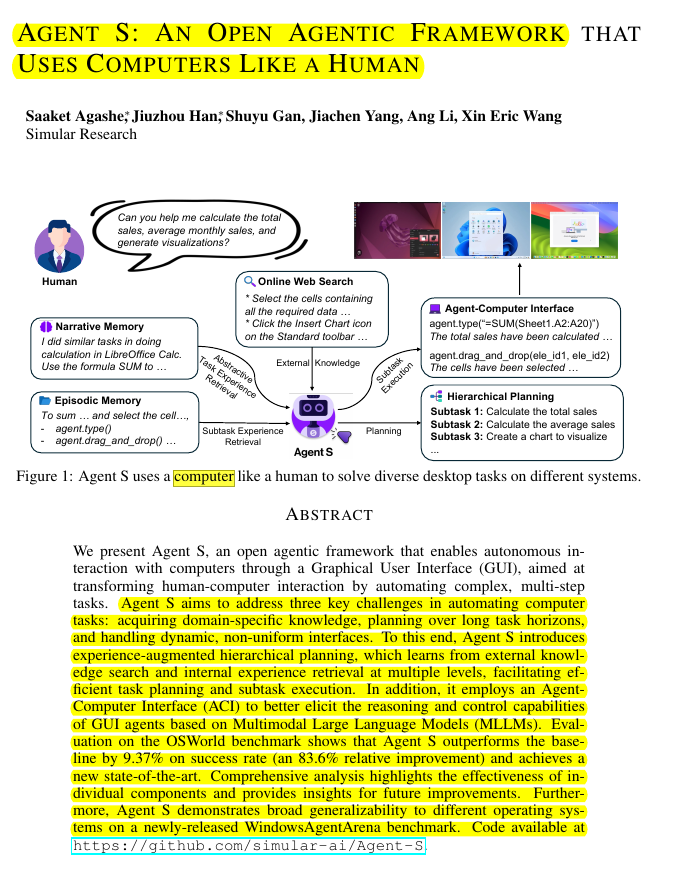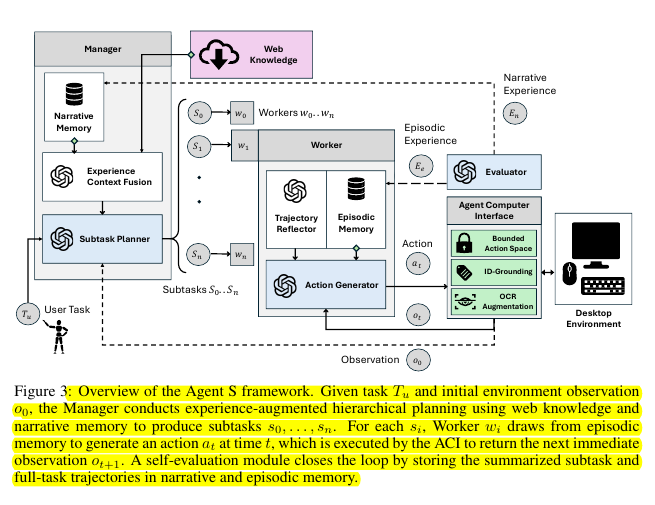Agent S: An Open Agentic Framework that Uses Computers Like a Human
Significant development for the power of AI Agents, they are learning to use GUIs.
Significant development for the power of AI Agents, they are learning to use GUIs.
Agent-S uses a computer like a human to solve diverse desktop tasks on different systems, by breaking them down into bite-sized actions and remembering what works.
Experience-augmented hierarchical planning enables Agent S to handle diverse GUI tasks with improved performance.
The original Problem 🎯:
Automating complex computer tasks presents challenges in acquiring domain-specific knowledge, planning over long task horizons, and handling dynamic interfaces.
Solution in this Paper 🛠️:
• Experience-augmented hierarchical planning:
Manager module for task decomposition
Worker modules for subtask execution
Self-evaluator for experience summarization
• Agent-Computer Interface (ACI):
Dual-input strategy for visual understanding and element grounding
Bounded action space of language-based primitives
• Continual memory update mechanism for ongoing learning
Key Insights from this Paper 💡:
• Combining external knowledge and internal experience enhances task planning
• Structured interface improves MLLM reasoning for GUI control
• Hierarchical planning supports long-horizon workflows
• Continual learning enables adaptation to new tasks and environments
Results 📊:
• OSWorld benchmark: 20.58% success rate (83.6% relative improvement over baseline)
• Consistent improvements across five computer task categories
• WindowsAgentArena: 18.2% success rate (36.8% improvement without adaptation)
• Ablation studies confirm effectiveness of individual components
🤖 Agent S addresses three main challenges in automating computer tasks:
Acquiring domain-specific knowledge for diverse applications
Planning over long task horizons
Handling dynamic, non-uniform interfaces
🧠 Agent S handles the experience-augmented hierarchical planning work by
A Manager module that decomposes complex tasks into subtasks using web knowledge and narrative memory
Worker modules that execute subtasks using episodic memory and trajectory reflection
A self-evaluator that summarizes experiences as textual rewards, updating narrative and episodic memories
Agent-Computer Interface (ACI) improves agent performance
The ACI is an abstraction layer that:
Uses a dual-input strategy: visual input for understanding environmental changes and an image-augmented accessibility tree for precise element grounding
Defines a bounded action space of language-based primitives conducive to Multimodal Large Language Model reasoning
Generates environment transitions at the right temporal resolution for observing immediate feedback




